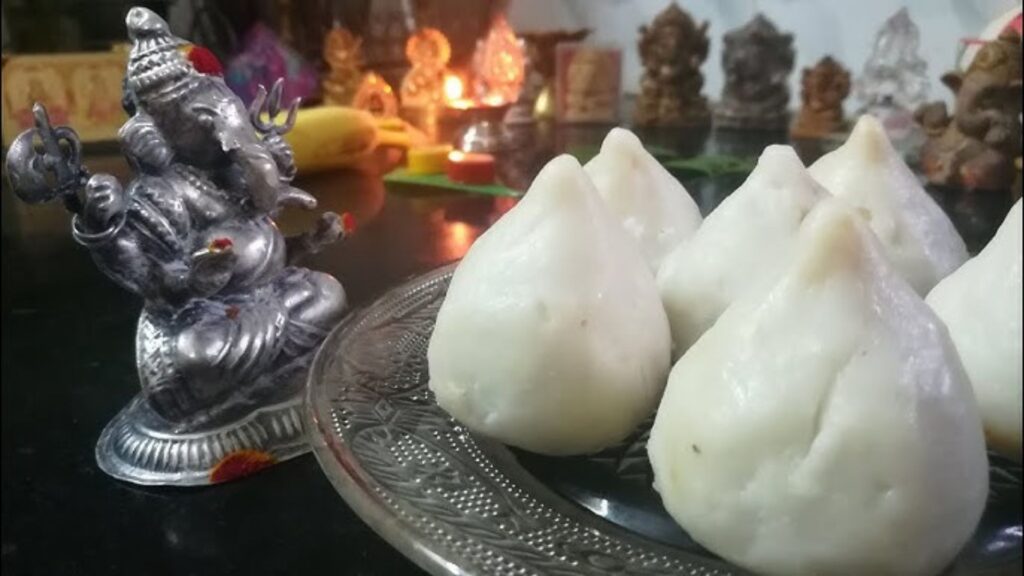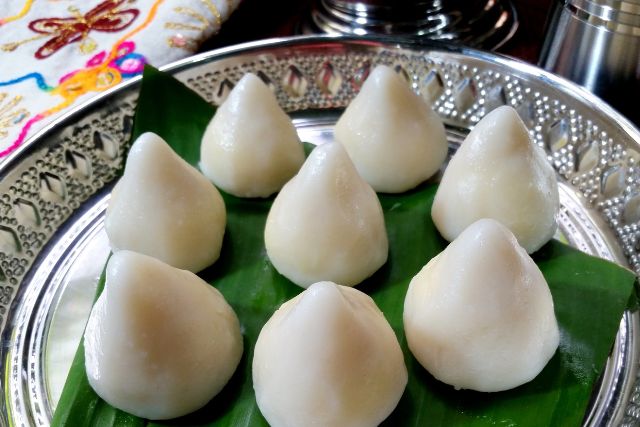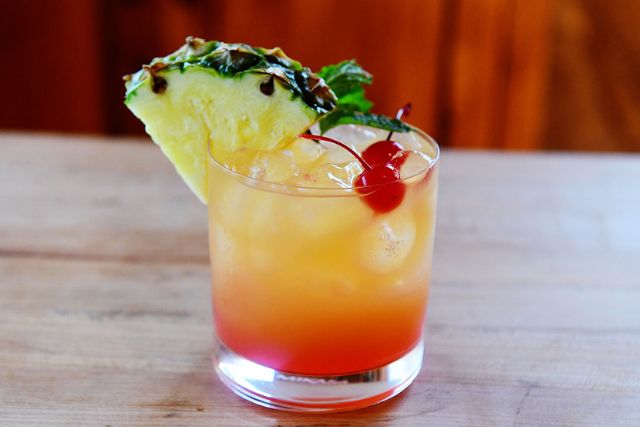Mothagam Recipe: A Sweet Delight for Ganesh Chaturthi
Ganesh Chaturthi is a time of vibrant celebrations, rich traditions, and delicious food. Among the array of dishes prepared during this festival, Mothagam stands out as a cherished sweet treat. Also known as Vella Kozhukattai, this traditional South Indian delicacy is a staple during Ganesh Chaturthi. In this comprehensive guide, we will explore the Mothagam recipe in detail, highlighting its significance, variations, and tips to perfect this sweet treat.
Understanding Mothagam Recipe
Mothagam, often referred to as Vella Kozhukattai in Tamil, is a steamed sweet dumpling made primarily from rice flour, jaggery, and coconut. This dish is an integral part of Ganesh Chaturthi celebrations, paying homage to Lord Ganesha, the deity of wisdom and prosperity. The sweet, aromatic filling encased in a delicate rice flour shell symbolizes the sweetness of life and the essence of devotion.
Ingredients for Mothagam Recipe
To prepare Mothagam, you’ll need the following ingredients:
For the Filling:
- 1 cup grated fresh coconut
- 1 cup jaggery (grated or chopped into small pieces)
- 1 tablespoon ghee (clarified butter)
- 1/2 teaspoon cardamom powder
- A pinch of salt
- Optional: 2 tablespoons of roasted sesame seeds or chopped nuts for added texture
For the Outer Cover:
- 1 1/2 cups rice flour
- 1 cup water (adjust as needed)
- 1/2 teaspoon salt
- 1 tablespoon ghee (clarified butter)
Preparation of Mothagam Recipe

- Preparing the Filling:
- Heat the ghee in a pan over medium heat.
- Add the grated coconut and sauté for a couple of minutes until it releases a pleasant aroma.
- Add the jaggery to the pan and continue to cook, stirring constantly until the jaggery melts completely and combines with the coconut.
- Mix in the cardamom powder and salt. Cook the mixture for an additional 2-3 minutes until it thickens slightly. If desired, add roasted sesame seeds or chopped nuts.
- Remove from heat and let the mixture cool down.
- Preparing the Outer Cover:
- In a large mixing bowl, combine rice flour and salt.
- Gradually add water to the flour, mixing continuously to form a smooth, pliable dough. The consistency should be similar to playdough—soft but not sticky.
- Add a tablespoon of ghee to the dough and knead it well. This will help in making the dough more pliable and less sticky.
- Assembling the Mothagam:
- Take a small portion of the dough and flatten it into a small disc using your fingers or a rolling pin. The disc should be about 3-4 inches in diameter.
- Place a spoonful of the coconut-jaggery filling in the center of the disc.
- Carefully fold the edges of the disc over the filling to form a half-moon shape or a pouch, sealing the edges tightly to enclose the filling completely.
- Repeat this process with the remaining dough and filling.
- Steaming the Mothagam:
- Prepare a steamer by boiling water in the base. Line the steaming tray with a clean cloth or banana leaves to prevent the Mothagam from sticking.
- Arrange the prepared Mothagam on the steaming tray, ensuring they do not touch each other.
- Steam the Mothagam over medium heat for about 10-15 minutes or until they become firm and cooked through.
- Remove from the steamer and let them cool slightly before serving.
Variations of Mothagam Recipe
While the traditional Mothagam recipe is a classic, there are several variations you can try to suit different tastes and preferences:
- Puran Poli Style Mothagam: For a unique twist, you can use a Puran Poli filling, which is a blend of chana dal (split chickpeas), jaggery, and cardamom. This variation offers a richer flavor and is perfect for those who enjoy a hearty, nutty sweetness.
- Nutty Mothagam: Incorporate finely chopped nuts like cashews, almonds, or pistachios into the coconut-jaggery filling. The added crunch complements the soft outer cover beautifully.
- Coconut and Raisin Mothagam: Add a handful of raisins to the coconut-jaggery filling for a burst of sweetness and added texture.
- Chocolate Mothagam: For a modern twist, consider adding cocoa powder or melted chocolate to the coconut filling. This creates a rich, chocolatey version of the traditional Mothagam.
Tips for Perfect Mothagam Recipe
- Dough Consistency: The dough for the outer cover should be soft and pliable but not sticky. If it feels too dry, add a little more water; if too wet, add more rice flour.
- Filling Texture: Ensure the coconut-jaggery filling is thick enough to avoid leakage. If it’s too runny, cook it a bit longer to reduce excess moisture.
- Steaming: Proper steaming is crucial to ensure the Mothagam is cooked evenly. Avoid overcooking, as it can make the dumplings dry.
- Sealing: Make sure to seal the edges of the Mothagam tightly to prevent the filling from spilling out during steaming.
Ganesh Chaturthi Recipes: Complementing Mothagam
Mothagam is just one of the many dishes enjoyed during Ganesh Chaturthi. Here are some other popular recipes that complement this sweet treat:
- Kozhukattai (Uzhunnu Kozhukattai): A savory variant made with rice flour and urad dal (black gram), seasoned with spices and coconut. This savory dumpling is a perfect counterbalance to the sweetness of Mothagam.
- Modak: Another sweet dumpling, Modak is made with a similar coconut-jaggery filling but comes in various forms, including steamed and fried. It’s a favorite offering to Lord Ganesha.
- Sundal: A nutritious, spicy snack made with chickpeas or other legumes, seasoned with mustard seeds, curry leaves, and coconut. It’s a great addition to the festive spread.
- Puran Poli: A sweet flatbread stuffed with a filling of chana dal and jaggery. It pairs well with Mothagam and adds variety to the festive menu.
Mothagam, or Vella Kozhukattai, is more than just a sweet treat; it’s a symbol of devotion, tradition, and the joy of celebration. This beloved recipe not only delights the taste buds but also brings families together during Ganesh Chaturthi with this recipes. By following the steps and tips outlined in this guide, you can create perfect Mothagam that will be the highlight of your festive spread.
Whether you’re a seasoned cook or a beginner, mastering the Mothagam recipe will enhance your Ganesh Chaturthi celebrations and provide a sweet touch to your offerings to Lord Ganesha. Enjoy the process, savor the flavors, and celebrate the festival with joy and reverence. Happy Ganesh Chaturthi!
FAQs
What is the difference between Mothagam and Modak?
Mothagam (Vella Kozhukattai) and Modak are both sweet dumplings offered to Lord Ganesha, but they differ in their outer cover and shape. Mothagam has a rice flour outer cover and is shaped like small balls or dumplings, while Modak typically has a coconut-based outer cover and is shaped like a conical dumpling with pleats.
Can I use pre-grated coconut for the filling?
Yes, you can use pre-grated coconut for the filling. However, fresh coconut is preferred as it gives a richer flavor. If using pre-grated coconut, ensure it is moist and not too dry.
How do I store leftover Mothagam?
Leftover Mothagam can be stored in an airtight container at room temperature for up to 2 days. For longer storage, keep them in the refrigerator. Reheat them lightly before serving to restore their softness.
Can I make Mothagam ahead of time for Ganesh Chaturthi?
Yes, you can prepare Mothagam a day or two in advance. Steam them, let them cool completely, and store them in an airtight container. Reheat them before offering or serving.
What can I substitute for jaggery in the Mothagam recipe?
If you don’t have jaggery, you can substitute it with brown sugar or white sugar. However, jaggery adds a distinct flavor and color, so the taste may differ slightly with other sweeteners.






